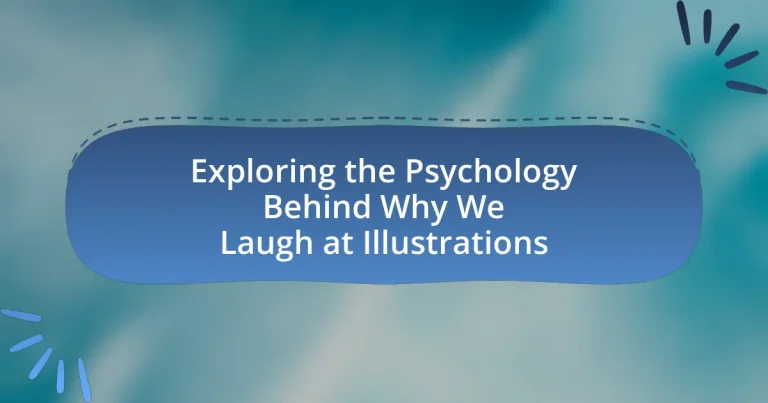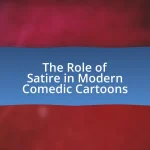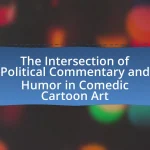The article delves into the psychology behind laughter in response to illustrations, primarily through the lens of incongruity theory, which explains how humor arises from discrepancies between expectations and reality. It explores various psychological theories, including superiority and relief theories, that elucidate why certain illustrations evoke laughter. Additionally, the article examines the influence of cultural factors, the role of surprise, and the impact of context and audience mood on humor perception. Techniques for illustrators to effectively evoke laughter, such as exaggeration and visual puns, are also discussed, highlighting the importance of audience feedback in refining humorous content.

What is the psychology behind laughter at illustrations?
Laughter at illustrations is primarily driven by the incongruity theory, which posits that humor arises when there is a discrepancy between expectations and reality. This psychological mechanism engages cognitive processes, as individuals recognize the unexpected elements in an illustration that deviate from normality or logic, prompting a humorous response. Research indicates that the brain’s reward system is activated during laughter, reinforcing the enjoyment derived from these incongruities. For instance, a study by Martin and Ford (2018) highlights that humor, including laughter at visual stimuli, is linked to cognitive appraisal and emotional responses, demonstrating how illustrations can elicit laughter through their surprising or absurd content.
Why do we find illustrations humorous?
We find illustrations humorous because they often exaggerate reality, creating a juxtaposition between expectation and outcome that triggers laughter. This humor arises from cognitive processes where the brain recognizes incongruities, such as absurd situations or unexpected character expressions, leading to a release of tension and amusement. Research indicates that humor is linked to the brain’s reward system, which responds positively to these incongruities, reinforcing the enjoyment of humorous illustrations.
What psychological theories explain laughter in response to illustrations?
Laughter in response to illustrations can be explained by several psychological theories, primarily the incongruity theory, the superiority theory, and the relief theory. The incongruity theory posits that humor arises when there is a discrepancy between what is expected and what actually occurs, which is often seen in illustrations that present unexpected or absurd scenarios. For example, a cartoon depicting a serious situation in a humorous light can trigger laughter due to this incongruity.
The superiority theory suggests that laughter occurs when individuals feel a sense of superiority over others depicted in the illustrations, such as characters experiencing misfortune or embarrassment. This can be observed in caricatures or satirical illustrations that highlight the flaws of individuals or groups, eliciting laughter from the audience.
Lastly, the relief theory posits that laughter serves as a release of psychological tension. Illustrations that address taboo subjects or societal norms can provide a safe outlet for expressing repressed emotions, leading to laughter as a form of relief. For instance, humorous illustrations that tackle sensitive topics can allow viewers to confront these issues in a less threatening manner.
These theories collectively illustrate the complex psychological mechanisms behind laughter in response to illustrations, highlighting the interplay of expectation, social dynamics, and emotional release.
How do cultural factors influence our laughter at illustrations?
Cultural factors significantly influence our laughter at illustrations by shaping the context, symbols, and humor styles that resonate with individuals. Different cultures have unique norms, values, and experiences that dictate what is considered funny or acceptable, leading to variations in humor appreciation. For instance, a study by McGraw and Warren (2010) found that humor often relies on incongruity, which is interpreted differently across cultures; what may be humorous in one culture could be offensive or nonsensical in another. Additionally, cultural references and social taboos embedded in illustrations can either enhance or hinder the comedic effect, as seen in the varying reception of political cartoons across different societies. Thus, cultural background plays a crucial role in determining the laughter elicited by illustrations.
What role does surprise play in humor related to illustrations?
Surprise is a critical element in humor related to illustrations, as it creates an unexpected twist that elicits laughter. When an illustration presents an incongruity or a sudden shift in context, it disrupts the viewer’s expectations, leading to a humorous response. Research in psychology indicates that humor often arises from the juxtaposition of familiar elements in unfamiliar ways, which is a hallmark of effective illustrations. For example, a cartoon that depicts a serious situation with absurd characters can provoke surprise, triggering amusement. This mechanism aligns with the incongruity theory of humor, which posits that humor is derived from the perception of something unexpected or out of place.
How does the element of surprise contribute to laughter?
The element of surprise significantly contributes to laughter by creating an unexpected shift in perception that triggers a cognitive response. When an individual encounters a situation or illustration that defies their expectations, the brain processes this incongruity, leading to amusement. Research by Peter McGraw and his colleagues in the “Benign Violation Theory” suggests that humor arises when something is perceived as a violation of social norms but is simultaneously seen as benign, allowing for laughter as a coping mechanism. This interplay between surprise and incongruity is fundamental in eliciting laughter, as it engages the brain’s reward system, reinforcing the pleasurable experience associated with humor.
What types of illustrations are most effective at creating surprise?
Illustrations that employ unexpected juxtapositions, visual puns, and surreal elements are most effective at creating surprise. These types of illustrations challenge viewers’ expectations by presenting familiar objects or scenarios in unfamiliar contexts, which can evoke a sense of humor or astonishment. For instance, a study published in the journal “Cognitive Science” by authors such as Thomas W. Simpson and David A. Rosenbaum indicates that incongruity in visual stimuli leads to increased engagement and surprise responses. This demonstrates that illustrations that defy logical reasoning or conventional representations are particularly impactful in eliciting surprise.
How does context affect our laughter at illustrations?
Context significantly influences our laughter at illustrations by shaping the interpretation and emotional response to the visual content. For instance, cultural background, situational factors, and prior experiences can alter how humor is perceived in an illustration. Research indicates that humor is often context-dependent; a study by M. J. Apter in “The Psychology of Humor” highlights that the same illustration can elicit laughter in one context while being perceived as unfunny in another due to differing social norms or expectations. Thus, the surrounding context plays a crucial role in determining the effectiveness of humor in illustrations.
What situational factors enhance or diminish humor in illustrations?
Situational factors that enhance humor in illustrations include context, cultural relevance, and timing, while factors that diminish humor include ambiguity, lack of relatability, and inappropriate content. Context plays a crucial role; for example, an illustration that aligns with current events or social issues can resonate more with viewers, making it funnier. Cultural relevance is significant as humor often relies on shared experiences or knowledge, which can vary widely across different demographics. Timing, such as the placement of an illustration within a narrative, can also amplify its comedic effect. Conversely, ambiguity can confuse the audience, reducing the humor’s impact. Lack of relatability makes it difficult for viewers to connect with the illustration, while inappropriate content can alienate or offend, leading to diminished humor.
How does the audience’s mood impact their response to illustrations?
The audience’s mood significantly influences their response to illustrations by affecting their emotional engagement and interpretation of the visual content. When individuals are in a positive mood, they are more likely to perceive illustrations as humorous or enjoyable, enhancing their overall experience. Conversely, a negative mood can lead to a critical or dismissive interpretation, reducing the likelihood of finding humor or appreciation in the illustrations. Research indicates that mood states can alter cognitive processing, with positive moods facilitating more creative and flexible thinking, which can enhance the enjoyment of humorous illustrations. For example, a study by Isen et al. (1987) found that individuals in a positive emotional state were more likely to engage in divergent thinking, which is essential for appreciating humor in visual art.
What are the cognitive processes involved in laughing at illustrations?
The cognitive processes involved in laughing at illustrations include perception, interpretation, and emotional response. Initially, perception allows individuals to visually process the illustration, identifying key elements such as characters, actions, and context. Following this, interpretation involves recognizing humor through cognitive frameworks, such as incongruity theory, where the unexpected or absurd elements in the illustration trigger a humorous response. Finally, the emotional response is activated, leading to laughter as a social and psychological reaction. Research indicates that humor appreciation is linked to brain activity in areas such as the prefrontal cortex and limbic system, which are responsible for decision-making and emotional regulation, respectively.
How do we interpret visual humor in illustrations?
Visual humor in illustrations is interpreted through the recognition of incongruity, where unexpected elements create a humorous effect. This interpretation relies on cognitive processes that identify contrasts between what is expected and what is presented, often leading to surprise or amusement. Research indicates that humor arises when illustrations juxtapose familiar scenarios with absurd or exaggerated features, prompting a cognitive shift that elicits laughter. For instance, a study by M. R. McGhee in “Humor: Its Origin and Development” highlights how incongruity theory explains the mechanics of humor, emphasizing that the brain’s processing of visual stimuli plays a crucial role in understanding and appreciating humor in illustrations.
What mental mechanisms are activated when we laugh at illustrations?
Laughter at illustrations activates several mental mechanisms, primarily involving cognitive processing, emotional response, and social context. Cognitive processing occurs as individuals interpret visual humor, recognizing incongruities or absurdities within the illustration. This recognition triggers an emotional response, often resulting in amusement or joy, as the brain releases neurotransmitters like dopamine, which are associated with pleasure. Additionally, social context plays a role; laughter can serve as a social signal, fostering connections among viewers who share similar interpretations of the humor. Research indicates that humor appreciation is linked to the brain’s reward system, reinforcing the pleasurable experience of laughter in response to illustrations.
How can understanding the psychology of laughter improve illustration design?
Understanding the psychology of laughter can significantly enhance illustration design by enabling designers to create visuals that resonate emotionally with audiences. By recognizing that laughter often arises from incongruity and surprise, illustrators can incorporate unexpected elements or juxtapositions in their work, making the illustrations more engaging and memorable. Research indicates that humor activates the brain’s reward system, leading to increased retention and positive associations with the content. For instance, a study published in the journal “Psychological Science” by Robert R. Provine highlights that laughter is a social signal that fosters connection, suggesting that illustrations that evoke laughter can strengthen viewer engagement and community. Thus, leveraging the principles of laughter psychology allows illustrators to craft designs that not only entertain but also enhance viewer interaction and emotional impact.
What techniques can illustrators use to evoke laughter effectively?
Illustrators can effectively evoke laughter by employing techniques such as exaggeration, visual puns, and absurdity. Exaggeration amplifies features or situations, making them humorous; for instance, a character with an oversized head can create a comedic effect. Visual puns play on words through imagery, where the illustration visually represents a double meaning, enhancing the humor. Absurdity introduces illogical or surreal elements that defy expectations, prompting laughter due to their unexpected nature. These techniques align with psychological principles of humor, such as incongruity theory, which suggests that humor arises when there is a discrepancy between what is expected and what occurs.
How can feedback from audiences enhance the humor in illustrations?
Feedback from audiences can enhance the humor in illustrations by providing insights into what resonates with viewers and what does not. This feedback allows illustrators to understand the nuances of comedic timing, cultural references, and visual gags that effectively elicit laughter. For instance, studies have shown that humor is often subjective and context-dependent; therefore, audience reactions can guide artists in refining their work to better align with the preferences and sensibilities of their target demographic. By analyzing audience responses, illustrators can identify successful elements and adjust their techniques, leading to more impactful and humorous illustrations.
What practical tips can enhance the humor in illustrations?
To enhance humor in illustrations, artists should focus on exaggeration, timing, and relatable scenarios. Exaggeration amplifies features or actions, making them more humorous; for instance, depicting a character with an oversized head can create a comedic effect. Timing, such as the placement of visual punchlines, is crucial; a well-timed element can evoke laughter by surprising the viewer. Additionally, incorporating relatable scenarios allows audiences to connect with the humor, as shared experiences often elicit laughter. Research indicates that humor often arises from incongruity and surprise, which these techniques effectively leverage.


